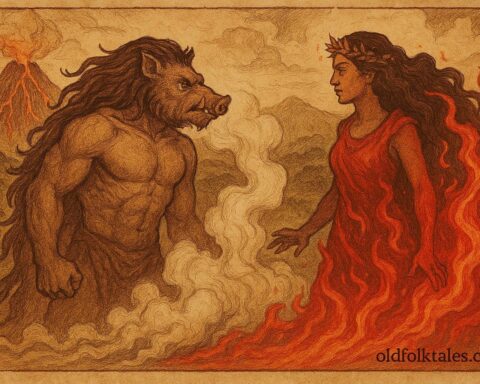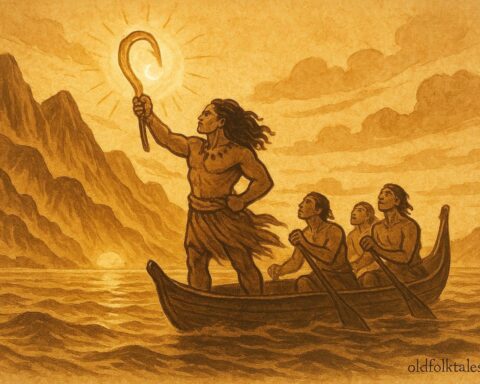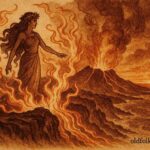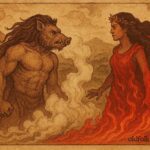In the ancient times before the world was shaped, before land, sea, and sky were divided, there existed only darkness and silence. The heavens had not yet lifted, and the earth had not yet awakened. The gods of creation slept in the void, dreaming of what might be. From that boundless stillness, two spirits began to stir: Rumia, the god of the heavens, and Pāpā, the goddess who would become the mother of Earth.
The Awakening of Rumia and Pāpā
Rumia was a being of radiant potential, his essence was light, though light had not yet been born. His presence shimmered faintly in the void like the promise of dawn. Pāpā, vast and nurturing, was the embodiment of the hidden earth, her form heavy with dreams of growth, shelter, and life yet to come.
Though they dwelled apart, Rumia above in the heavens of shadowed air, Pāpā below in the sleeping body of the earth, they felt each other’s presence through the nothingness. In the silence between them pulsed a rhythm, a heartbeat of attraction, calling them to unite.
When Rumia’s breath reached Pāpā, it stirred her from stillness. She rose, unfolding from the depths, her voice soft and resonant, echoing through the void like the first sound. “Who calls to me from above the darkness?” she asked.
“It is I,” answered Rumia. “I am the sky seeking its foundation. Without you, I am endless and empty. Together we may bring form to the formless.”
Their words became the first wind, gentle at first, then growing into the breath of creation.
The Union of Sky and Earth
Drawn by longing, Rumia descended from the heavens and embraced Pāpā. When they touched, their love became the spark that pierced the darkness. A soft glow shimmered across the vast emptiness, not yet light, not yet shadow, but something between. From their embrace came the first dawn and dusk, a sacred mingling of opposites.
This blending of darkness and light was the first po, the sacred night, giving birth to the first ao, the sacred day. In that moment, the universe awakened.
The warmth of their union spread across the heavens, and their sighs became the winds that would forever circle the world. Their tears, shed in joy, fell as the first rain. From Pāpā’s body rose the contours of the land, valleys and mountains, and from Rumia’s radiance came the glimmering dome of the sky.
The Children of Pāpā and Rumia
From this union of love and light were born many children, each carrying a part of their parents’ essence. Their firstborn was Marama, the spirit of the moon, who would govern the rhythm of tides and the calm of night. Next came Ra‘i, the spirit of the sun, who brought heat and illumination, marking the hours of the day.
Their breath gave birth to the Matagi, the winds, gentle breezes, trade winds, and mighty storms. From their whispers emerged the Fetū, the stars, who filled the night sky with memory and direction for all voyagers yet to come.
Each child took its place in the grand balance of creation, light and dark, calm and storm, sky and earth, forming the rhythm by which the world would live. And so began the endless turning of day into night, night into day, the heartbeat of time itself.
The Balance of Light and Darkness
Yet even in their love, there was longing and struggle. Rumia’s radiance grew strong, and at times he wished to shine always upon Pāpā, to bathe her in endless light. But Pāpā, wise and nurturing, knew that constant brightness would exhaust her children. The seeds of life needed both rest and renewal.
So Pāpā said to Rumia, “Beloved, though your light gives warmth, too much will scorch the children we have brought forth. Let us share the world between us, you for day, and I for night, so that all things may live in balance.”
Rumia, moved by her words, agreed. And thus they divided the heavens: when Rumia rose, his brilliance filled the sky and awoke the world; when he sank, Pāpā’s cool shadow returned, bringing calm and restoration.
Their love became the eternal cycle, the rising and setting of the sun, the passing of moon and stars, the breath between day and night.
The Eternal Promise
Though Rumia dwelled above and Pāpā below, their hearts remained bound. Each dawn and dusk was their meeting, the tender moment when light and shadow touched once more. In the orange glow of sunrise and the violet hush of twilight, their love renewed the world.
To this day, the people of Tahiti remember Pāpā and Rumia as the first lovers, whose embrace created harmony between earth and sky. Their story teaches that all things, even opposites, are meant to exist together in balance. Love is not only passion but also the force that gives life its rhythm and meaning.
When the wind stirs the leaves or when the morning sun kisses the ocean, the ancient ones say: It is Pāpā and Rumia greeting each other once again.
Discover the adventures of Māui, Pele, and Tangaloa in the timeless Polynesian oral tradition
Moral Lesson
The tale of Pāpā and Rumia reminds us that harmony is born from balance, between light and darkness, strength and gentleness, sky and earth. Love, when guided by wisdom, becomes the creative force that sustains all life.
Knowledge Check (Q&A)
- Who are Pāpā and Rumia in Tahitian mythology?
Pāpā is the goddess who became the mother of Earth, and Rumia is the god of the heavens. Their union created the first dawn and dusk. - What event marked the creation of light and shadow?
When Pāpā and Rumia united in love, their embrace brought forth the first blending of darkness and light, the first dawn and dusk. - What were the children of Pāpā and Rumia?
Their children were the moon, the sun, the stars, and the winds,forces that govern time and the rhythms of nature. - What moral lesson does this legend teach?
That harmony and life come from the balance between opposites,love, light, and darkness working together. - What do dawn and dusk symbolize in this story?
They represent the eternal meeting of Pāpā and Rumia, the union of earth and sky, and the cycle of renewal. - How does the legend explain the origin of day and night?
It teaches that day and night were created by the separation and reunion of Pāpā and Rumia, ensuring balance in the world.
Source: Adapted from “Tahiti: Memoirs of the Bernice Pauahi Bishop Museum,” Vol. 48 (translated from the Orsmond Manuscripts, early 19th century), published by Teuira Henry (1928).
Cultural Origin: Tahitian (Society Islands)












